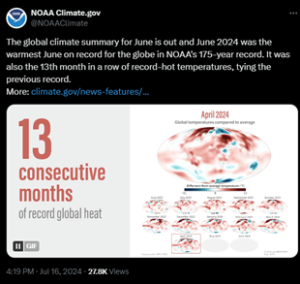This site uses cookies to provide you with a more responsive and personalized service. By using this site you agree to our use of cookies. You can learn more about our use of cookies and similar technologies and your choices by reviewing our Privacy Policy. By clicking “I agree” you agree to our use of cookies and similar technologies.
Protecting Organizations from Extreme Heat Waves Across the United States
June 2024 broke global records as the hottest month according to the National Oceanic and Atmospheric Administration’s (NOAA’s) 175-year dataset. It was also the 13th month in a row of record-high temperatures, tying the previous record set during the May 2015 – May 2016 span for the longest record warm global temperature streak in the modern record (since 1980).

Protecting Employees and Mitigating Risk
Just two months into summer, the vast majority of the United States has already experienced an extreme heat wave. In early July, over 130 million people were under heat warnings across the western U.S. with dangerous temperatures reported.[1] As temperatures soar, what does this mean for companies and how can we better protect our employees? Under the federal law that created the Occupational Safety and Health Administration (OSHA), employers always have a duty to keep their workplace free of known hazards. Failure to address heat risk and exposure can result in fines and other regulatory consequences.
Consequences for Employers
Failure to comply with OSHA regulations regarding heat exposure can result in fines and potential legal action. For example, earlier this year, OSHA issued three (3) citations to Amazon for exposing workers to dangerous heat conditions, including not reminding workers to take breaks and not providing adequate shade.[2] In another instance, OSHA fined an Alabama general contractor over $16,000 in penalties after a worker died of heat illness in 2023.[3] Employees may also file workers compensation claims leading to increased insurance premiums and potential financial liabilities. Legal and regulatory consequences may also result in reputation damage for employers, affecting customer or investor trust, and low employee morale resulting in high turnover rates and difficulty attracting new talent.
At Guidepost, we recommend organizations leverage the following recommendations to keep your employees safe during periods of extreme heat:
- Have a Heat Illness Prevention Plan. Ensure that your organization has a written plan in place to prevent heat-related illnesses. We recommend utilizing OSHA’s resources to better understand employer responsibilities and guide plan development.
- Plan for Power Outages. Ensure that your organization is checking its backup generators and supplies for functionality. Understand how generators will work in the event the power goes out and the air conditioning stops functioning.
- Consider the maximum indoor temperature levels for workers dictated by the state and county where the organization’s sites are located. Have a plan in place if workers cannot continue to work onsite due to heat. For example, California, Colorado, Minnesota, Oregon, and Washington all have OSHA-approved State Plans that dictate heat standards for employees working indoors
- Consider Outdoor Worksite Safety. Take precautions for worksites that are not air conditioned and add cooling spaces, shade, and options to get out of the heat for breaks where possible.
- Make Water Easily Accessible. Encourage staff to drink plenty of water even if they do not feel thirsty and encourage them to avoid caffeinated or alcoholic drinks. Staff members with certain medical conditions may need to consult a doctor before increasing liquid intake.
- Dress for the Heat. Encourage employees to wear light-colored, loose fitting, breathable clothing.
- Recognize and Act if Signs of Heat-Related Illnesses. Train staff to know the signs of heat-related illnesses (heat exhaustion and heat stroke) and ways to respond. First aid for heat-related illness involves the following principles:
- Take the affected worker to a cooler area (e.g., shade or air conditioning).
- Cool the worker immediately.
- Where appropriate, remove outer layers of clothing (e.g., heavy protective clothing).
- Use fans to circulate air around the worker.
- Never leave a worker with heat-related illness alone. Heat-related illnesses can rapidly become worse. Stay with the worker.
- For emergencies, call 9-1-1![4]
- Identify Cooling Options. Identify places in your organization’s community where employees (and their loved ones) can go to get cool. To find locations of cooling centers, call 2-1-1 or check local media reports.
- Understand Heat-Related Risk. Follow your local National Weather Service (NWS) Forecast Office and refer to NWS’s Heat Risk scale: https://www.wpc.ncep.noaa.gov/heatrisk/.
Proposed Rule to Protect Indoor and Outdoor Workers
According to the Bureau of Labor Statistics (BLS), 479 workers in the United States died from exposure to environmental heat from 2011-2022, an average of 40 fatalities per year in that time period. In response to the recent heat wave, the U.S. Department of Labor (DOL) has released a proposed rule with the goal of protecting millions of workers from the significant health risks of extreme heat. If finalized, the proposed rule would help protect approximately 36 million workers in indoor and outdoor work settings and substantially reduce heat injuries, illnesses, and deaths in the workplace.
The proposed rule would require employers to develop an injury and illness prevention plan to control heat hazards in workplaces affected by excessive heat. Among other things, the plan would require employers to evaluate heat risks and — when heat increases risks to workers — implement requirements for drinking water, rest breaks, and control of indoor heat. It would also require a plan to protect new or returning workers unaccustomed to working in high heat conditions.[5]
The Bottom Line
The extreme heat wave is expected to persist in the coming months, reflecting a broader trend of increasingly frequent and severe heat waves over the past decade. At Guidepost, we are closely monitoring the DOL’s proposed rule and working with our clients to help them understand and mitigate the risks posed by extreme heat. We strongly advise organizations to be proactive: assess the risks, develop robust life-safety and preparedness plans, and regularly train employees to ensure their safety. For those without the expertise or bandwidth to tackle these challenges alone, partnering with an expert like Guidepost can provide invaluable support and guidance.
[1] https://www.pbs.org/newshour/nation/records-continue-to-tumble-as-relentless-heat-wave-grips-large-parts-of-the-country
[2] https://www.vice.com/en/article/pka87y/summer-was-scary-amazon-fined-for-not-giving-workers-enough-shade-water
[3] https://www.al.com/news/2024/02/alabama-contractor-fined-16131-after-contractor-dies-working-in-107-degree-heat-index.html
[4] https://www.osha.gov/heat-exposure/illness-first-aid
[5]https://www.osha.gov/news/newsreleases/national/07022024#:~:text=Among%20other%20things%2C%20the%20plan,working%20in%20high%20heat%20conditions

Andrew Abernathy
Senior Consultant
Andrew Abernathy is a senior consultant at Guidepost and specializes in emergency management, crisis management, and economic development planning. Mr. Abernathy is a seasoned consultant with a proven track record of successfully leading and delivering complex projects within budget and time constraints. He is an experienced emergency and crisis management professional with expertise across FEMA, NIST, ISO, NFPA and UN standards, as well as the EMAP accreditation process.


